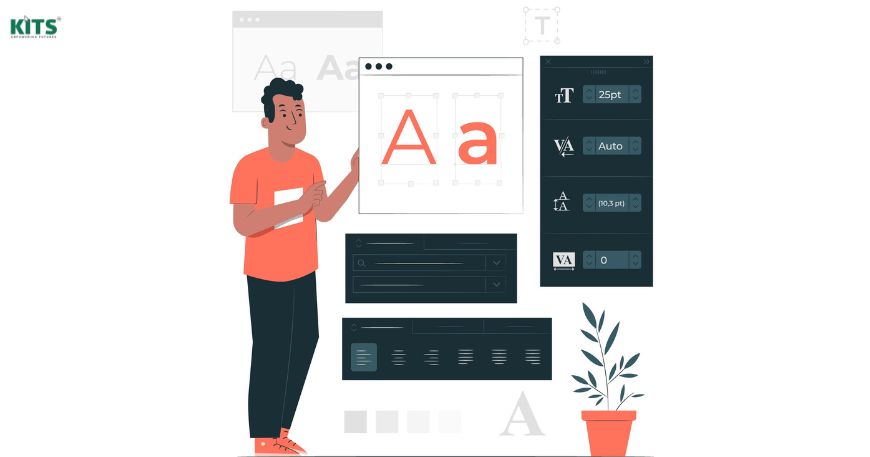Improve your design skills with the ultimate guide to the best typography and Layout Design courses in 2024. Explore the importance of typography, key course features, top recommendations, and tips for success. Learn how mastering typography can elevate your graphic design and web development career.
Introduction to Typography Courses
Typography is a fundamental aspect of design that significantly influences how information is communicated. In 2024, the importance of typography skills has never been more pronounced, as businesses and individuals increasingly recognize its impact on branding, user experience, and visual appeal. Typography encompasses the art of arranging type to make written language legible, readable, and visually engaging. This guide, provided by KITS (Kyaas Institute of Technical Skills), aims to offer insights into the best typography courses available this year, helping you enhance your skills and stand out in the competitive design landscape.
Why Typography Courses Matter
Evolution of Typography in Digital Media
Typography has evolved dramatically with the advent of digital media. From print to screen, the principles of typography have adapted to meet the needs of various platforms and audiences. As designers and content creators, understanding these changes is essential to effectively convey messages and engage users. Typography and Layout Design courses equip learners with the knowledge needed to navigate these shifts and apply modern techniques in their projects.
Impact of Good Typography on User Experience
Good typography is more than just aesthetics; it plays a crucial role in user experience (UX). Effective typography enhances readability, establishes hierarchy, and guides users through content seamlessly. By investing in typography courses, learners can master the nuances of type selection, spacing, and layout, ultimately improving the user experience of their designs.
Key Features of Top Typography Courses
When considering typography courses, it’s essential to evaluate their features. Here are some key aspects to keep in mind:
Course Duration and Flexibility
The duration and flexibility of a course are crucial for busy individuals. Look for courses that offer both full-time and part-time options, allowing you to balance your studies with other commitments.
Curriculum Highlights and Practical Applications
A well-rounded curriculum should cover both theoretical concepts and practical applications. Look for courses that include hands-on projects, real-world case studies, and opportunities for feedback from instructors.
Top 5 Typography Courses of 2024
Here are some of the best typography courses available in 2024:
1. The Complete Typography Course for Designers
Overview: This course covers the fundamentals of typography, including type anatomy, font pairing, and typographic hierarchy. It features hands-on projects that help students apply what they learn in real-world scenarios.
Duration: 10 hours of on-demand video
Level: Beginner to Intermediate
2. Typography for Designers
Overview: This course dives into the history and evolution of typography, teaching students how to create effective typographic designs. It includes assignments that challenge learners to develop their typographic style.
Duration: Approximately 4 weeks, 3-4 hours per week
Level: Beginner
3. Creative Typography
Overview: Focusing on the creative aspects of typography, this course explores how to use type to express concepts visually. It includes practical exercises and student projects to foster creativity.
Duration: 1 hour and 15 minutes
Level: All levels
4. Advanced Typography: Type Design and Use
Overview: This advanced course teaches students how to create custom typefaces and apply typography principles in various design contexts. It includes in-depth discussions on letterform design and typographic systems.
Duration: 3 hours
Level: Advanced
5. Typography: The Art of Type
Overview: This course offers insights into the artistic side of typography, covering hand lettering, type manipulation, and creating expressive type compositions. Students will complete projects that enhance their portfolio.
Duration: 6 hours
Level: Intermediate to Advanced
Choosing the Right Typography Course
Selecting the right typography course requires careful consideration. Here are factors to keep in mind:
Factors to Consider Before Enrolling: Assess the course structure, instructor expertise, and student support.
Matching Course Objectives with Career Goals: Ensure that the course aligns with your career aspirations, whether in graphic design, web development, or other related fields.
Benefits of Learning Typography in 2024
Typography is a cornerstone of design that shapes how information is communicated and perceived. In 2024, mastering typography offers numerous benefits, especially as design continues to evolve with technology and changing user expectations. Here’s an in-depth look at why learning typography is more crucial than ever:
1. Career Opportunities in Graphic Design and Web Development
As the digital landscape grows, the demand for skilled designers who understand typography increases. Whether you’re a graphic designer, web developer, or UX/UI specialist, proficiency in typography can significantly enhance your job prospects. Employers value candidates who can create visually appealing and user-friendly designs, making typography an essential skill.
Graphic Design: Typography is integral to creating logos, branding materials, and print layouts. Designers with strong typographic skills can craft visually compelling work that communicates a brand’s message effectively.
Web Development: Web developers who understand typography can better collaborate with designers to create websites that are not only functional but also visually coherent and engaging. Typography enhances readability, guides user interaction, and contributes to a positive user experience.
2. Edges of Mastering Typography Tools and Techniques
Learning typography in 2024 means gaining access to advanced tools and techniques that streamline the design process and allow for greater creativity. Software like Adobe Illustrator, Photoshop, and specialized typography tools like Glyphs or FontLab have evolved to offer powerful features that can elevate your designs.
Precision and Control: Modern typography tools allow for precise control over every aspect of type design, from kerning and tracking to creating custom typefaces. Mastering these tools enables you to refine your work to a professional standard.
Efficiency: Knowing how to use typography tools efficiently can save time on projects, allowing you to focus on creativity and innovation. Automated features like responsive type scaling or typeface libraries make it easier to maintain consistency across different platforms.
3. Enhanced Creativity and Design Flexibility
Typography is not just about choosing a font; it’s about using type as a design element to convey emotion, style, and brand identity. By learning typography, you unlock new avenues for creativity. Understanding how to manipulate typefaces, experiment with layouts, and integrate typography into various design elements can lead to more innovative and impactful work.
Expressive Designs: Typography allows you to express ideas and emotions uniquely. By experimenting with typefaces, spacing, and layout, you can create designs that stand out and resonate with your audience.
Design Consistency: A strong grasp of typography ensures that your designs maintain a consistent and professional appearance, regardless of the medium. This consistency is crucial for building brand identity and recognition.
4. Improved Communication and User Experience
Good typography goes beyond aesthetics; it plays a crucial role in how effectively a design communicates its message. Poor typography can lead to confusion, misinterpretation, and a negative user experience. Conversely, well-executed typography enhances clarity, guides the reader, and improves overall engagement.
Readability: Typography directly impacts readability, which is essential for conveying information clearly and efficiently. By learning how to choose the right typefaces and arrange text effectively, you can make your content more accessible and enjoyable for users.
Hierarchy and Emphasis: Typography helps establish a visual hierarchy, guiding users through content logically and intuitively. Knowing how to use different types sizes, weights, and styles can help emphasize key points and lead users to the most important information.
5. Staying Ahead of Industry Trends
The field of typography is constantly evolving, with new trends and techniques emerging regularly. By learning typography in 2024, you position yourself to stay ahead of these trends, ensuring that your skills remain relevant and in demand.
Adapting to New Media: As new media platforms emerge, typography must adapt to different screen sizes, resolutions, and interaction methods. Understanding current trends in digital typography, such as variable fonts or responsive typography, ensures that your designs are future-proof.
Incorporating Emerging Technologies: Technologies like AI and machine learning are beginning to influence typography, from automated typesetting to personalized font suggestions. Being at the forefront of these innovations can give you a competitive edge in the design industry.
Tips for Success in Typography Courses
To excel in typography courses, consider the following tips:
Study Habits and Time Management Tips: Establish a consistent study routine, break tasks into manageable chunks, and prioritize hands-on practice.
Resources and Communities for Typography Enthusiasts: Join online forums, attend workshops, and connect with fellow typography enthusiasts to share insights and gain inspiration.
Future Trends in Typography Education
As technology continues to evolve, so does typography education. Here are some trends to watch:
Emerging Technologies and Their Impact: AI and machine learning are beginning to influence type design and accessibility in typography.
Predictions for Typography Courses Beyond 2024: Expect an increase in courses focusing on interactive typography and dynamic content as digital media continues to expand.
Conclusion
Typography skills are vital for anyone looking to thrive in the design industry. By exploring and enrolling in the best typography and Layout Design courses in 2024 through KITS, you can enhance your expertise and stay relevant in the evolving design landscape. The knowledge and skills gained from these courses will not only improve your designs but also open doors to new career opportunities.
FAQs about Typography Courses in 2024
FAQ 1: What are the prerequisites for taking a typography course?
Most typography courses do not have strict prerequisites, but a basic understanding of design principles can be beneficial.
FAQ 2: How long does it take to become proficient in typography?
The time to proficiency varies, but with consistent practice and coursework, many students achieve a strong understanding within a few months.
FAQ 3: Can typography skills be self-taught?
Yes, typography skills can be self-taught through online resources, books, and practice, although structured courses provide valuable guidance.
FAQ 4: Are online typography courses as effective as in-person classes?
Online courses can be just as effective as in-person classes, especially when they offer interactive elements and direct feedback from instructors.
FAQ 5: What career paths benefit most from typography expertise?
Careers in graphic design, web development, marketing, and content creation greatly benefit from strong typography skills, enhancing overall design quality and user experience.



